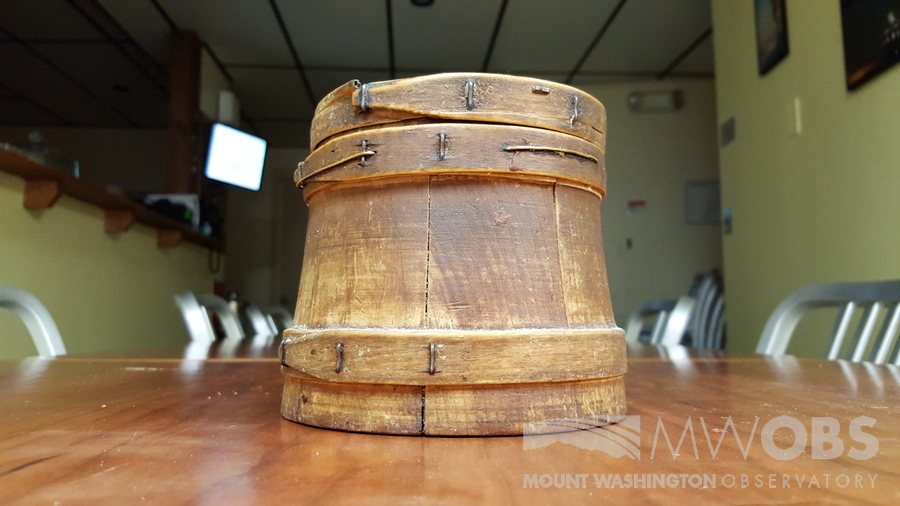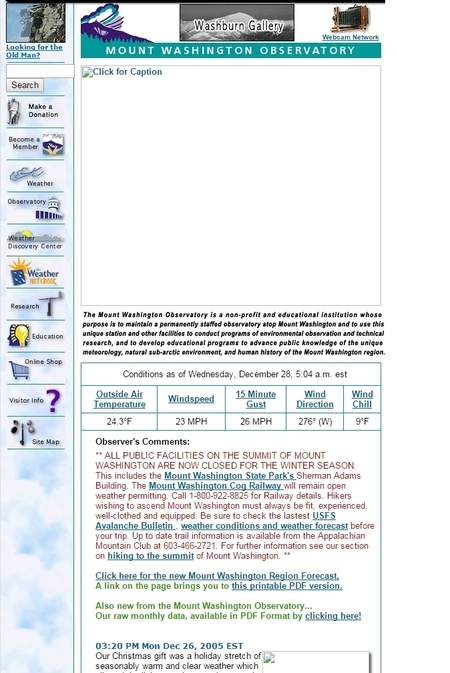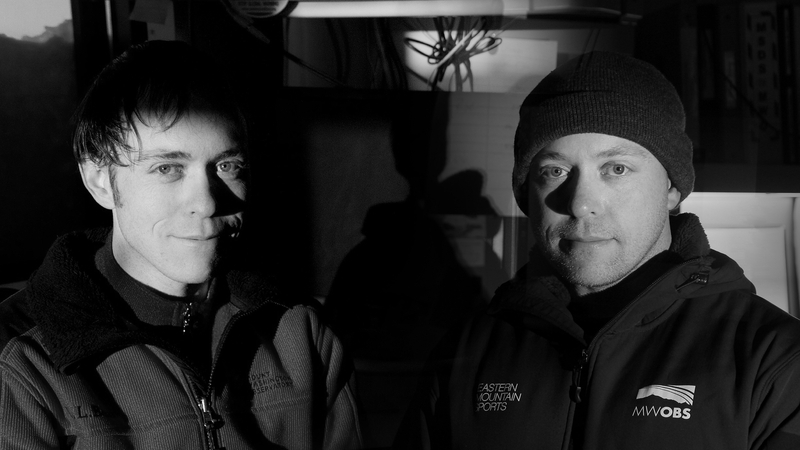A Decade Of Observing Mount Washington’s Weather
2015-12-28 15:33:27.000 – Ryan Knapp, Weather Observer/Staff Meteorologist
Ten years ago to this day (December 28, 2005), I started working at the Mount Washington Observatory. I started as an intern but a month or so after arriving as an intern I was hired on as a temporary-full time observer. What this title meant was I was hired as an observer but I had until the end of my internship (May 2006) for the Observatory and I to decide whether or not I should continue as a full time observer. Since I am writing this comment now, I guess you could say we both agreed that a full time position would be mutually beneficial.
This past week leading up to this date, I started to think of how many things have changed in my ten years here. We have touched upon many of these in past comments but just in case you missed them, here is what’s changed in my ten years here:
-Our Bombardier snow tractor went from the unheated, bench-seated, yellow school bus to the heated, captain-seated, white “leopard.”
-A limited water storage capacity meant the rule of “if it’s yellow let it mellow; if it’s brown flush in down” was etched in our minds. We were limited to one military shower per week but most of us opted not to take one at all. In short, water in was fine but water out should be as limited as possible. There were times where even buckets were looked at for an option. But now with the year-round septic system, water restrictions are a complete mystery to new observers, volunteer, and interns since water out is no longer an issue.
-Due to the limited water out rule, toilets were pressurized to assist the high volume to get to the tanks. So our toilet was up on a platform with a bunch of pressurizing equipment. This system was eventually replaced when a new septic system was installed but the elevated platform remained. This year though, our bathroom was gutted and it now sits flush to the ground. Also gone – the tub (which I only recall one person ever using) which is now a shower stall.
-Our bunks were once prison-cell-esque…that might be too harsh; dorm-room-esque. They were uncomfortable and hard to sleep in. But now they have been overhauled and I can now get a solid 6 hours of sleep and not the 3-4 I used to get sleeping during the day in them.
-Looking around the Observatory space there have been a ton of changes, and not a single room looks like it did when I first started here; I could probably write an entire comment just on that alone. But at least the sugar container remains; fun fact – it is one of the oldest items on the summit still in use spanning decades and multiple generations of Observers.
 MWO sugar container
MWO sugar container
-The hum and smell of the power generators was like a white noise machine. The “switch over” between the two generators was a regular occurrence. And lights were on everywhere to make them run more efficiently. Now with a buried power line, nights are only noisy when winds are high and the air smells crisp. And all unnecessary lights are turned off to cut down on power costs.
-Our logo went from a blue and magenta 80s/90s look to the red and white modernized one that plasters the very website you are on.
-Our website is completely different. In fact, this is the fifth iteration of how it looks since I got here. The original website when I started here can be outdone by most teenagers with a weeknight of coding nowadays. Obscast, forums and pdf copies of Windswept among other features didn’t even exist when I started and some of those elements no longer exist today.
 Website on 28 Dec 2005
Website on 28 Dec 2005
-Weather models have improved as computer processing speeds have improved. Some weather models have been discontinued while others didn’t even exist when I started.
Higher Summits Forecasting was 36 hours and done in the morning when I started. However, because of improvements in the various models, it now goes out 48 hours and is done twice a day.
-Time sheets were due Wednesday and now they are due Mondays.
-Work weeks could mean just that-back to back weeks. There was one time I was up here three weeks in a row. The only ones with the week on week off scheduling back then were the interns. Nowadays, we all are on the week on week off scheduling with little to no exceptions (except if we take vacation time off).
-Crews were two observers and one intern. And with the staggering schedules, no two weeks would have the same crew. This meant there was no set crews and we got to work with and know everyone. Now, there are three observers and one to two interns on each shift. We are on the same crew for long periods of time with very little interactions going on except on Wednesday and the occasional visits during off weeks.
–
Volunteers were hard to come by. I remember several weeks of not having volunteers up here. Now there are waiting lists for particular dates and from what I’ve heard, when we don’t have a volunteer up here, people freak out.
-Computer screens and the television were CRT and now are LCD.
-Smartphones and tablets weren’t around. Cell phones existed but service was non-existant. So when you came up, you were disconnected, which was kind of nice to be completely honest.
-Social media didn’t exist!
-Where once VHS’s and Playstation 2 were the only things being watched on our TV, we eventually got a DVD collection. And now there is Video on Demand (Netflix, Hulu, etc). To think, events like the Super Bowl had to be missed when up and now we can stream it.
-The server room was spacious then got filled up as technology came about, but then shrunk back down as technology improved, got smaller, and more efficient.
-The Cog still was running all coal when I started and now it is powered by biodiesel (with the exception of one coal train a day in the summer).
-Various structures and buildings have been torn down and removed; looking at historical pictures spanning decades, this is one of the lowest amount of structures present on the summit.
-With the exception of one or two of the valley staff, both summit and valley crews are completely different than when I started. If I counted correctly, on the summit alone I have worked with 2 cats, 4 Summit Managers, 11 Bombardier (Snow Cat) Operators, 15 museum attendants, 24 Observers, 79 interns/externs (excluding a handful of temp-interns that only came up for a week or two for school), and 100+ volunteers (some of which have been coming up here as long as I have been working here).
–
Distance Learning didn’t exist. So the whole command center the the Educational Observers use didn’t exist except for a lonely Polycom for a few connections with the Weather Discovery Center from time to time. And live video feeds with news stations – forget about it (the internet wasn’t fast enough)
-Specific job titles and specific qualifications didn’t exist. We were all just Weather Observers. Now we have a staff meteorologist/observer, distance learning specialist/observer and IT specialist/observer on each shift.
-Partnerships with companies have come and go. While I hate seeing those partnerships end, I have enjoyed each of them as we have pulled some awesome companies and individuals on board over the years.
–
Seek the Peak has expanded exponentially. I remember a time when we had left over goodie bags, believe it or not. Now we have to put a cap on the number of participants.
-“Automated” equipment we have owned and were testing are no longer around due to our destructive winds and ice. Even the equipment we use regularly has gone through replacement and repairs.
-Research projects like Airmap, COSMO, and others either no longer exist or had their requirements changed as technology improved.
I’m sure I could go on and on but I think I have touched upon the big changes I have witnessed. Hopefully you can see how much has changed in just ten year’s time. Since I am all about photography and history (it was my minor), I like to look at historical pictures from the 1930s and 1940s and really see how much has changed on the summit. And who knows how much more will change in the next year, five, or ten. However, while crews, living quarters, quality of life, job titles, technology, etc are continuously evolving and changing up here, one thing has remained and will remain constant up here even after me and this crew departs: the recording and reporting of the weather.
 Ten Year difference – 2005 left and 2015 right
Ten Year difference – 2005 left and 2015 right
Ryan Knapp, Weather Observer/Staff Meteorologist
 MWO sugar container
MWO sugar container Website on 28 Dec 2005
Website on 28 Dec 2005 Ten Year difference – 2005 left and 2015 right
Ten Year difference – 2005 left and 2015 right



